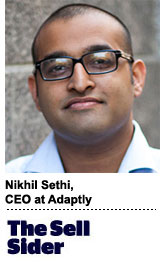 “The Sell Sider” is a column written for the sell side of the digital media community.
“The Sell Sider” is a column written for the sell side of the digital media community.
Today’s column is written by Nikhil Sethi, co-founder and CEO at Adaptly.
The multitude and impossible size of the Internet has led the ad tech industry to focus on scale and efficiency by pushing standardization upon publishers. By enforcing standards on publishers, it became possible to advance scale, efficiency and trading without worrying about the nuances of individual publisher environments.
But as publishers became more standardized, the fundamental experiences for consumers and advertisers alike became increasingly static. Where commoditization was the priority, the only way to continually create value was to add abstraction layers, such as networks, exchanges and demand-side platforms.
However, more publishers are investing in delivering unique experiences for their users, which do not conform to the media formats of the industry’s self-imposed ad standards. These autonomous marketing platforms led to the development of their own ecosystems, in which both consumers and marketers are “users,” and where content and advertising are delivered, consumed and interacted with in the same way.
These platforms are truly independent and have woken up to the banality of conformity. Hence, the burden of standardization needs to be shifted away from the publisher and onto technology. Technology will allow us to scale advertising efficiently across the Internet while preserving the quality of experience between publishers and their users.
Potential Benefits
Shifting the burden of standardization to technology allows individual publishers to focus on innovating and developing a better experience for consumers while providing consistent workflow for marketers to engage with audiences at scale. Not only will we continue to enjoy the gains from programmatic interfaces and rapid at-scale decisions, but these gains can be further advanced within the context of autonomous marketing platforms, allowing us to take greater steps forward in developing more dynamic relationships between brands and people vs. viewing inherent fragmentation as a tough reality.
The IAB has provided concrete guidelines on the existing publisher-centric standardization framework. Its stated ad formats and standardization purpose: “To support consistency in ad formats and delivery methods so the marketplace can realize efficiencies and scale in ad buying and selling as well as ad creation.”
The IAB’s invaluable efforts have paved the way to where we are today. But by assuming that the realization of efficiencies and scale in ad buying is only possible by publisher-side standardization, I believe we limit the ingenuity of the creative mind and spirit by constraining ourselves to draw within the lines.
License To Innovate
AdExchanger Daily
Get our editors’ roundup delivered to your inbox every weekday.
Daily Roundup
Ultimately, we are moving to a world where any given person may have a multitude of platforms/publisher use cases. This is not a zero-sum publisher world because each environment offers something compelling for a consumer to do, which may be so unique that it defies categorization.
Even a broad label like “social” is oversimplified as it implies autonomous marketing platforms, such as Twitter and Facebook, offer the same fundamental consumer use cases. But do you create and consume media from Twitter and Facebook in the same way? What about Pinterest, Instagram and Tumblr? And do you send messages on mobile apps like Kik and Snapchat in the same fashion and for the same reasons? Each platform is powerful and unique due to its ability to provide a canvas specific to its consumer value proposition.
Publishers are no longer imprisoned by the chains of conformity. Rather, I see a dramatic shift of the burden for ad standardization being placed on technology. The road may not be easy. We have only seen the first wave of autonomous marketing platforms. And, in addition to the fragmentation caused by the sheer number of new platforms emerging, they are springing up globally which adds another layer of complexity altogether. The technology answer will need to address all of these present-day challenges, while being developed in such a way that it may adapt to the constantly changing landscape.
This shift of burden toward technology will fundamentally allow publishers and platforms to innovate in respect to their core DNA and consumer propositions. The quality of experiences provided to consumers will produce better performance for marketers, along with the benefit that technology provides for reaching audiences at scale.
Follow Adaptly (@adaptly) and AdExchanger (@adexchanger) on Twitter.













